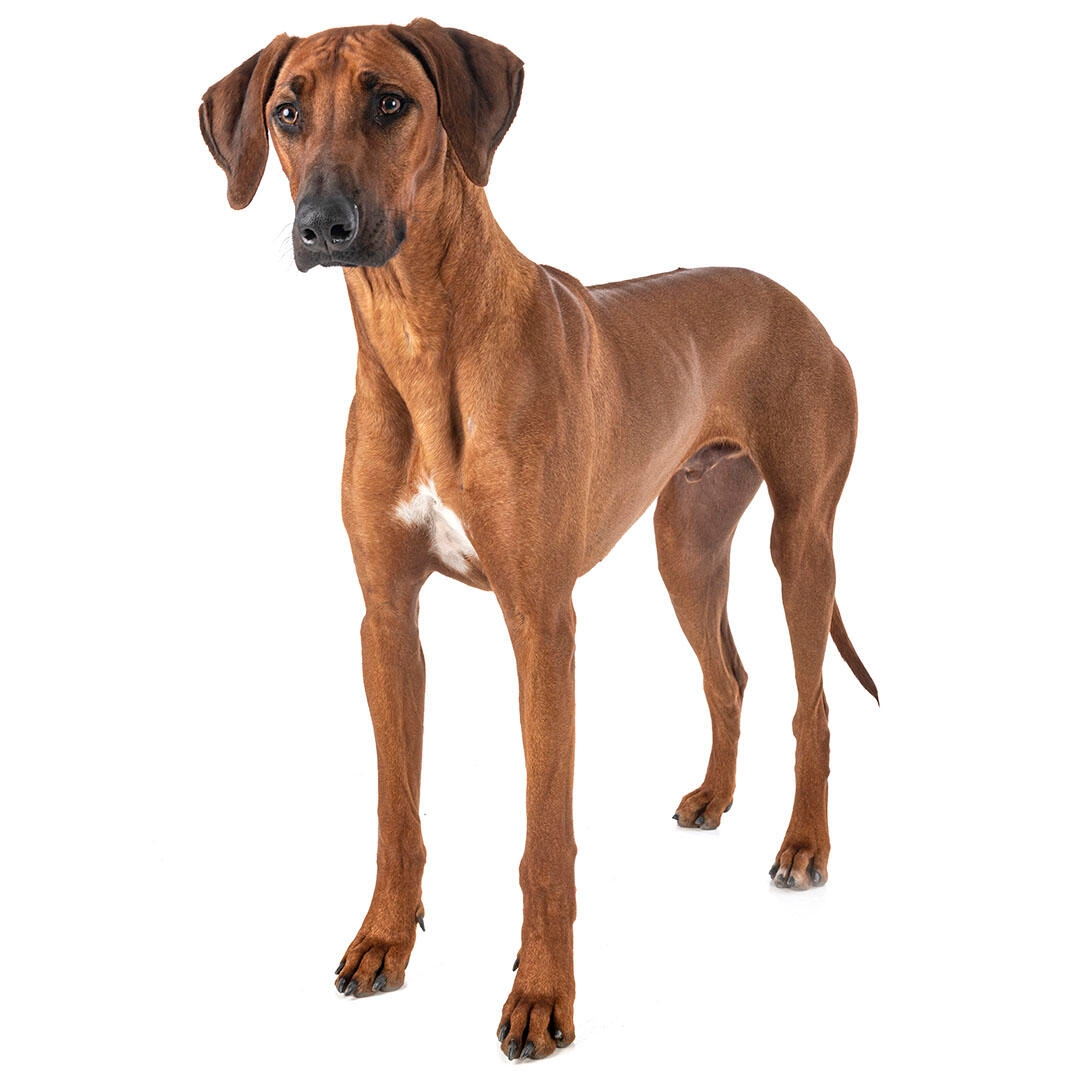
| Family-friendly: | 5/5 |
| Exercise needs: | 5/5 |
| Easy to train: | 2/5 |
| Tolerates being alone: | 2/5 |
| Likes other pets: | 4/5 |
| Energy level: | 4/5 |
| Grooming needs: | 4/5 |
| Shedding: | 4/5 |
The Rhodesian Ridgeback is predisposed to:
- Hip dysplasia
- Elbow dysplasia
- Gastric dilatation volvulus
- Juvenile myoclonic epilepsy occurs in young dogs and is a specific form of epilepsy- a condition where abnormal brain function can lead to seizures which damage the brain.
- Hypothyroidism¹ where the thyroid gland is underactive and does not product enough thyroid hormone. This can result in low energy levels, weight gain and skin problems.
- Dermoid sinus which is a condition where the skin is either attached to the spinal cord or the tissue overlying it.
Priority Kennel Club health schemes and testing:
- Hip dysplasia screening scheme
¹L. J. Kennedy, 'Association of canine hypothyroidism with a common major histocompatibility complex DLA class II allele', 2006, Tissue Antigens
The Rhodesian Ridgeback is a strong, powerful dog that can be determined and stubborn. Although quite friendly and confident at home, they are very wary of strangers - human and canine. Not the ideal breed for the novice owner, they need experienced handling and training, together with early, thorough and ongoing socialisation.
| Family-friendly: | 5/5 |
| Exercise needs: | 5/5 |
| Easy to train: | 2/5 |
| Tolerates being alone: | 2/5 |
| Likes other pets: | 4/5 |
| Energy level: | 4/5 |
| Grooming needs: | 4/5 |
| Shedding: | 4/5 |
This is a dog who has been known as the African Lion Dog which gives a good indication of what this powerful hound was originally bred to do. When European settlers came to southern Africa in the 17th century, they brought their large guarding dogs with them - a mixture of mastiffs, scenthounds and Great Danes - to protect their farms, and looked with scorn on the local ridge-backed dogs whom they often shot on sight. In time however they realised that these dogs were perfectly suited to the climate and had a resistance to tropical diseases, and so instead of killing them started to breed them with their own dogs to produce what they found to be the perfect breed for pursing African wild game. The resulting dogs were taken north to Rhodesia where they were further developed and worked with big games hunters who used them in small packs to hunt lions and leopards. By the 1920s the breed had become standardised and their popularity began to grow around the world.
This smart, attractive member of the Hound group will be ideal for those with hound experience, and excellent training skills. You’ll need to love both training and walking to give this dog their ideal home, although they’re happy to laze about if the weather turns windy and wet. Suited to rural or semi-rural homes or homes with big gardens and easy access to the countryside. The Ridgeback loves their family but can be unwelcoming to strangers (human or canine) and protective, so good socialisation (and fencing) is vital. Best with older children who can take part in walking and training, or child-free families.
The Rhodesian Ridgeback requires a couple of hours of daily exercise as an adult. Rhodesian Ridgebacks have strong hunting instincts, so should be in a safe open space away from other dogs before let of the lead - or else have long on-lead walks.
This is a dog who needs a large property and a securely fenced garden in a rural location, or with plenty of open space for daily exercise.
Large breed dogs, as well as having large appetites, benefit from a different balance of nutrients including minerals and vitamins compared to smaller-breed dogs. The Rhodesian Ridgeback is prone to bloating and stomach problems; smaller, more frequent meals can help minimise this risk. Check out our dog feeding guidelines for more information.
The Rhodesian Ridgeback is a low-maintenance dog breed when it comes to grooming. The coat shorthaired coat can be groomed using a rubber-grooming mitt once or twice a week.
Plenty of socialisation and dog training is needed to ensure this dog is a safe member of canine society. With consistent reward-based training, they can master a reliable recall and walking on the lead - along with other obedience exercises. But be aware that they can be selective in their obedience when faced with distractions.
The Rhodesian Ridgeback is not an ideal family dog. Although he can be very affectionate towards their own children, they may not be tolerant of their friends.
While many dogs are traditionally thought of as being good with children, all dogs and children need to be taught to get on with and respect each other, and be safe together. Even so, dogs and young children should never be left alone together and adults should supervise all interactions between them.